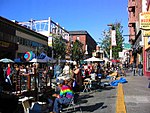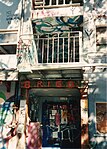Cody's Books
1956 establishments in California2008 disestablishments in CaliforniaAmerican companies established in 1956Bookstores established in the 20th centuryBookstores in the San Francisco Bay Area ... and 11 more
Companies based in Berkeley, CaliforniaCulture of Berkeley, CaliforniaDefunct companies based in the San Francisco Bay AreaDefunct retail companies of the United StatesHistory of the San Francisco Bay AreaIndependent bookstores of the United StatesRetail companies disestablished in 2008Retail companies established in 1956Use American English from June 2016Use mdy dates from June 2016Wikipedia references cleanup from September 2009

Cody's Books (1956–2008) was an independent bookstore based in Berkeley, California. It "was a pioneer in bookselling, bringing the paperback revolution to Berkeley, fighting censorship, and providing a safe harbor from tear gas directed at anti-Vietnam War protesters throughout the 1960s and 1970s."
Excerpt from the Wikipedia article Cody's Books (License: CC BY-SA 3.0, Authors, Images).Cody's Books
Telegraph Avenue, Berkeley
Geographical coordinates (GPS) Address Nearby Places Show on map
Geographical coordinates (GPS)
| Latitude | Longitude |
|---|---|
| N 37.8658 ° | E -122.2589 ° |
Address
Telegraph Avenue 2449;2454;2460;2464
94720 Berkeley
California, United States
Open on Google Maps









